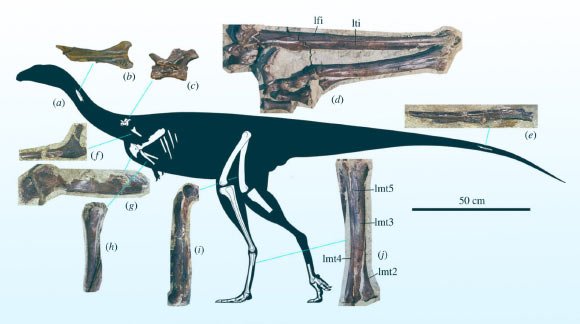Kiyacursor longipes is the first species of ceratosaur known from the Early Cretaceous of Asia, extending the stratigraphic range of the dinosaur group Ceratosauria by 40 million years on the continent.
Kiyacursor longipes, referred specimen (b) and holotype (c-j). Image credit: Averianov et al., doi: 10.1098/rspb.2024.0537.
The newly-discovered dinosaur species lived in what is now Siberia between 121 and 113 million years ago (Early Cretaceous epoch).
Named Kiyacursor longipes, the ancient creature had an estimated body length of 2.5 m (8.2 feet).
It belongs to Noasauridae, an extinct family of small predatory dinosaurs belonging to the group Ceratosauria.
“Ceratosauria is the first major radiation of theropod dinosaurs to have achieved great taxonomic diversity and wide geographical distribution,” said Zoological Institute’s Dr. Alexander Averianov and his colleagues.
“They were probably globally distributed in the Late Jurassic, but were displaced from the northern continents by other theropod groups and underwent secondary radiation on the Gondwanan landmasses during Cretaceous time, where they became dominant predators and survived until the end of the Cretaceous.”
“Abelisauroidea, the most diverse clade of ceratosaurs, is known from the Cretaceous of Europe where it is probably represented by secondary dispersals, but in Asia ceratosaurs were not known after the Late Jurassic.”
A fragmentary skeleton of Kiyacursor longipes — including cervical vertebra, pectoral girdle, humerus and hind limbs — was unearthed at Shestakovo 1 locality in the Ilek Formation in Western Siberia.
“Kiyacursor longipes shares unique hind limb proportions with Elaphrosaurus and Limusaurus, suggesting improved cursorial ability,” the paleontologists said.
“These species show an ostrich-like specialization of the pes, with a large third metatarsal and greatly reduced second metatarsal.”
“By contrast, all other fast running non-avian theropod dinosaurs have an arctometatarsalian pes, with the third metatarsal strongly reduced proximally.”
According to the authors, Kiyacursor longipes is about 40 million years younger than the previous youngest record of ceratosaurs in Asia.
“Kiyacursor longipes was part of an unusual vertebrate assemblage, dominated by an advanced ceratopsian dinosaur Psittacosaurus sibiricus, but also containing groups of tetrapods that have long since gone extinct in other regions, like stem salamanders, protosuchian and shartegosuchid crocodyliforms, tritylodontid synapsids and docodontan mammaliaforms,” they said.
The team’s work appears in the journal Proceedings of the Royal Society B.
_____
Alexander O. Averianov et al. 2024. The last ceratosaur of Asia: a new noasaurid from the Early Cretaceous Great Siberian Refugium. Proc. R. Soc. B 291 (2023): 20240537; doi: 10.1098/rspb.2024.0537
Discover more from CaveNews Times
Subscribe to get the latest posts sent to your email.


























![Exploring the Serene Beauty of Nature: A Reflection on [YouTube video title]](https://cavemangardens.art/storage/2024/04/114803-exploring-the-serene-beauty-of-nature-a-reflection-on-youtube-video-title-360x180.jpg)



























